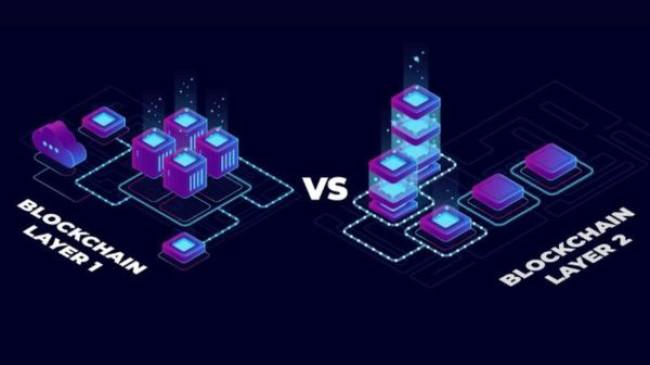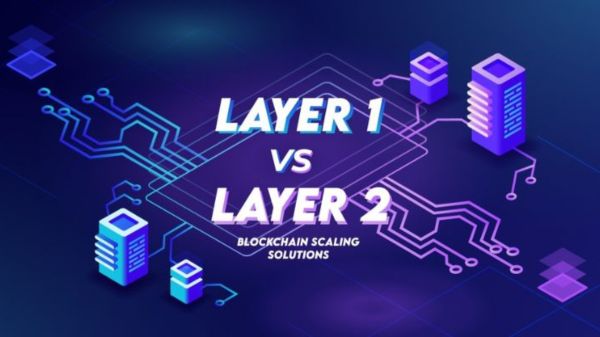Categories: General Information
What is a blockchain Layer 1 and Layer 2? Compare Blockchain layer 1 and layer 2
What is a layer 1 blockchain? What is a layer 2 blockchain? Difference between Layer 1 and Layer 2 Blockchain.
Layer 1 and layer 2 are terms that help us understand the architecture of different blockchains, projects, and development tools. If you've ever wondered, "What is a layer 1 blockchain?" or "What is a layer 2 blockchain?" learning about the different blockchain layers will be very beneficial.
Let's delve deeper into understanding blockchain Layer 1 and Layer 2, their advantages and disadvantages, as well as the reasons why they can mutually support each other in enhancing the sustainability of blockchain projects.
Table of Contents
- What is Layer 1 blockchain?
- Core components of Layer 1 Blockchain
- Layer 1 problems
- What is Layer 2 blockchain?
- How do Layer 2 scaling solutions work?
- Why is blockchain scalability important?
- Difference between Layer 1 and Layer 2
- Limitations of Layer 1 and Layer 2
- What is the future after Layer 1 and Layer 2?
What is Layer 1 blockchain?
What is layer 1 blockchain? Layer 1 blockchain technology serves as the underlying protocol that provides the fundamental infrastructure for blockchain networks. This distributed ledger technology (DLT) is specifically designed to securely record transactions on a public, immutable, and trustless ledger. Often referred to as the "core" or "foundation" of blockchain networks, layer 1 blockchains are considered the most basic form of blockchain technology upon which all other blockchain layers are built.

The layer 1 blockchain is responsible for maintaining the distributed ledger, validating transactions, and ensuring the security of the network from malicious actors. The consensus mechanism at the core of a layer 1 blockchain is critical to the validation and recording of transactions, ensuring the immutability and trustworthiness of the ledger. Common consensus mechanisms used on layer 1 blockchain networks include proof-of-work (PoW), proof-of-stake (PoS), and delegated proof-of-stake (DPoS).
The technology behind layer 1 blockchain is used as the foundation for many leading public blockchain networks, such as Bitcoin and Ethereum, as well as various decentralized applications (DApps) and protocols. By providing a secure and transparent way to record transactions, layer 1 blockchain technology has the potential to revolutionize various industries, including finance, supply chain, and healthcare.
Core components of Layer 1 Blockchain
Block production
The blockchain consists of blocks, which are produced by miners or validators and then recorded on the network's layer 1 chain. These blocks are data structures that include a reference to previously generated blocks in a chain and information about a new set of transactions. This allows for the creation of a public ledger, commonly known as the blockchain, which ensures that every transaction is accurately recorded and accounted for.
Transaction finality
Transaction finality is the concept that a transaction cannot be modified or undone after it has been confirmed. This confirmation point is reached when a transaction is recorded in an irreversible state on the blockchain. The time required for this confirmation can vary depending on the design of the blockchain. It is worth noting that while transactions may be processed on other layers or chains, they can only be finalized on the layer 1 blockchain, which provides the highest level of security and guarantees the authenticity of the recorded transactions.
Native assets
In the world of blockchain technology, there exists a distinction between coins and tokens. Coins such as BTC, ETH, ADA, and DOGE are utilized to pay transaction fees and reward miners or validators on L1 blockchains. These coins are essential to the operation of the L1 chain. Conversely, tokens like UNI, DAI, LINK, and SAND are utilized to power decentralized networks and applications built on layer 1.
Security
It is important to note that L1 chains define the parameters that are responsible for ensuring the security of a network. This encompasses which consensus mechanism a chain employs (e.g., Proof of Work, Proof of Stake) and the rules that govern how validators engage with a network. Although other blockchain layers may offer some security measures, L1s are the ultimate authority on ecosystem security. As such, L1 chains play a critical role in guaranteeing the integrity and trustworthiness of blockchain networks.
Layer 1 problems
Bitcoin and Ethereum are good examples of Layer 1 networks having trouble scaling, both decentralized systems that secure the network over distributed consensus. All transactions require independent verification from several nodes before being confirmed. It is an efficient way to log and record accurate, verified data to the blockchain; while minimizing the risk of attack by bad guys.
Throughput, though, will become an increasingly severe problem as its speed becomes the problem that holds it back. As the number of users increases, the workload on the Layer 1 blockchain also increases. As a result, processing speed and capacity decrease. This results in longer transaction processing times and higher fees.
What is Layer 2 blockchain?
Layer 2 refers to the second framework or protocol that is built on top of the existing Blockchain system, aiming to address the issues of transaction speed and scalability in Blockchain networks.

In a broader context, Layer 2 protocols encompass a range of solutions developed on layer 1 of any Blockchain, inheriting its characteristics. These protocols serve to facilitate transaction verification and minimize the burden on layer 1.
By utilizing Layer 2 protocols, Blockchain processes and transactions can be conducted independently from the original layer (Layer 1), effectively enabling "off-chain" scaling solutions.
One notable advantage of employing Layer 2 Blockchain solutions is that they can be added as an additional layer without necessitating any structural changes to Layer 1. Consequently, these Layer 2 scaling solutions can achieve high throughput while maintaining network security.
How do Layer 2 scaling solutions work?
Rollup
Rollups are Layer 2 blockchain scaling solutions that execute transactions outside the Layer 1 blockchain and post data from transactions to it. Since the data resides on the base layer, it allows Layer 1 to keep the rollup secure. Rollup helps increase transaction throughput, expand participation, and reduce gas fees for users.
Sidechains
Sidechains are independent blockchain networks that operate with their validation pools. This means that the smart contract bridging the main chain does not verify the validity of the sidechain network. Therefore, you need to trust that the sidechain is working correctly, as it can control the assets on the original chain.
Nested Blockchain (Plasma)
A nested Layer 2 blockchain operates on another blockchain. Basically, Layer 1 sets the parameters while the nested Layer 2 blockchain executes the processes. The principal is not involved in the execution of transactions, and its role is limited to resolving disputes where necessary. The daily work is assigned to the “child” chains, which bring the processed transactions back to the main chain after being completely off the main chain.
State Channel
State channels allow two-way communication between blockchain participants. As such, the participants can reduce the waiting time as no third party, for example, a miner, is involved in the process.
On the smart contract, the participants agreed in advance to seal part of the base class. They can then interact directly with each other, eliminating the need for miners to be involved. After processing the entire transaction, they add the final channel state to the blockchain.
Why is blockchain scalability important?

At its core, blockchain scalability refers to the system's ability to provide a rich experience to every user, regardless of the total number of users at any given time. The term “throughput” refers to the number of transactions that the system processes per second. While Visa - a traditional payment channel - operates close to 20,000 TPS, Bitcoin's main chain can only do 3 to 7 TPS.
Unlike Visa, a centralized network, Bitcoin uses a decentralized system that consumes more power and processing time to protect user privacy. Each data transaction has to go through many steps, including acceptance, mining, distribution, and validation by a network of nodes.
With cryptocurrencies growing in popularity and expected to be widely accepted in the world economy, blockchain developers are trying to increase the scope of blockchain processing. By creating blockchain layers and optimizing Layer 2 scaling, they want to speed up processing times and increase the number of TPS.
What is the difference between Layer 1 and Layer 2?
Layer 2 is a term used to refer to solutions that are created to solve scalability issues of Layer 1. Typically, Layer 2 is built on top of Layer 1 and inherits the security and availability characteristics of data from Layer 1. With the ability to process more transactions, Layer 2 helps reduce costs and increase transaction confirmation speed compared to Layer 1. Examples of Layer 2 blockchains include Polygon, X-dai, Immutable-X, Arbitrum, Loopring…
One of the examples of Layer 2 in the Bitcoin system is Lightning Network. This protocol allows peer-to-peer transactions to be performed quickly through nodes and dedicated software, while ensuring security and reliability by connecting to the main chain. Not only used in the Bitcoin system, Lightning Network is also used by other Layer 1 systems such as Litecoin to improve scalability and transaction speed.
Limitations of Layer 1 and Layer 2
Both Layer 1 and Layer 2 solutions have their pros and cons. Working on Layer 1 can help improve the protocol at scale. However, this also means that validators must be persuaded to accept the changes through a hard fork.

Layer 2 provides a much faster way to improve scalability. However, depending on the method used, you may end up sacrificing a lot of the security of the original blockchain. If you remove aspects of Layer 1, you often rely on Layer 2 teams and networks for efficiency and security.
What is the future after Layer 1 and Layer 2?
Scalability is one of the reasons why mass crypto adoption is not possible in the blockchain industry at the moment. As demand for cryptocurrencies increases, the pressure to scale blockchain protocols will also increase. Since both blockchain layers have certain limitations, the future solution will be to build a protocol to solve the scalability dilemma.
Conclusion
This article hopes to help you understand what Blockchain Layer 1 and Layer 2 are, as well as their pros and cons. At the time of posting, blockchain systems are still under development. The pressing question for the future is whether blockchain layers and Layer 2 scaling will be temporary or permanent. Up until this point, no one knows.
Follow Unicorn Ultra to update more interesting information and knowledge about blockchain.
